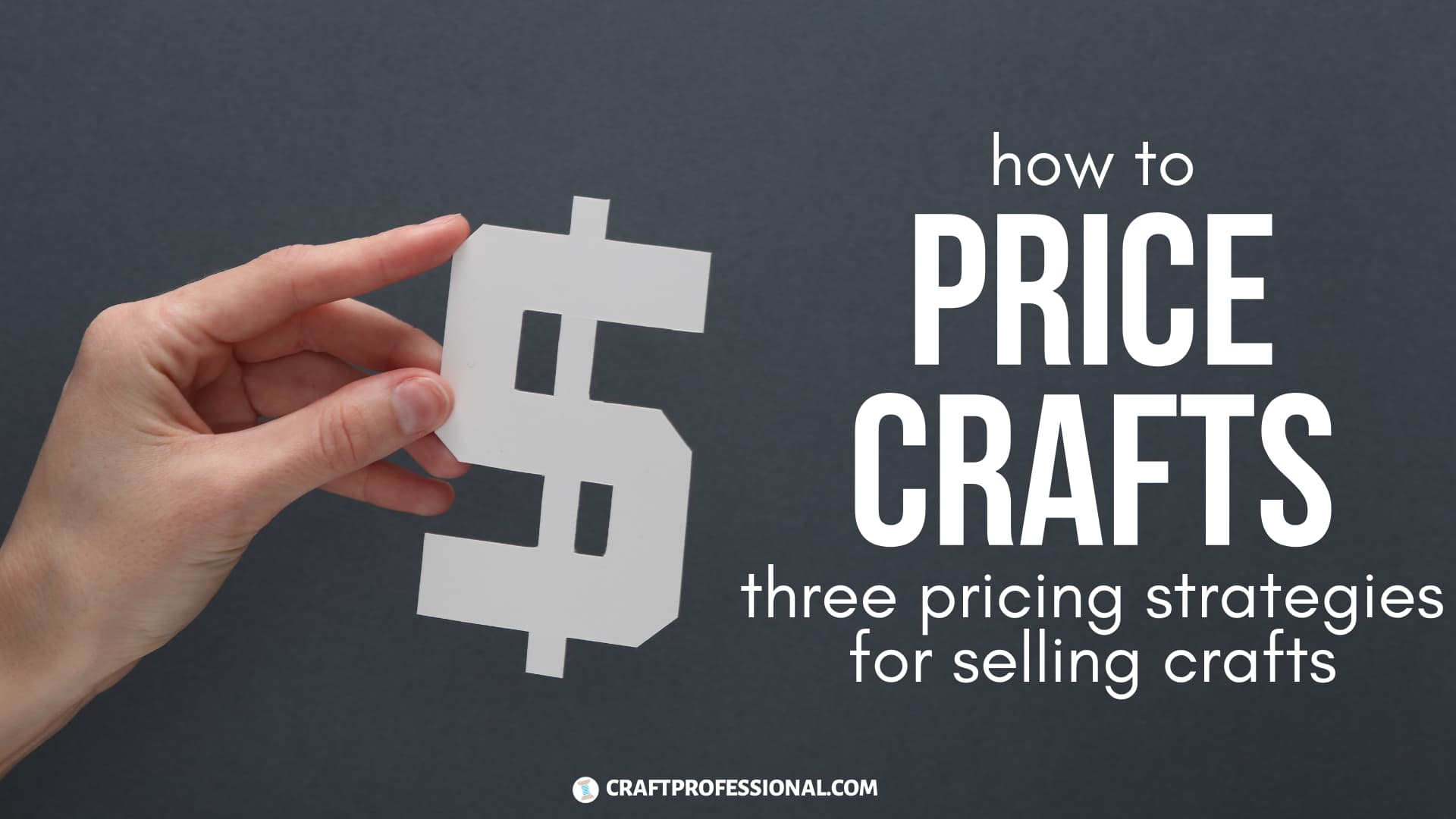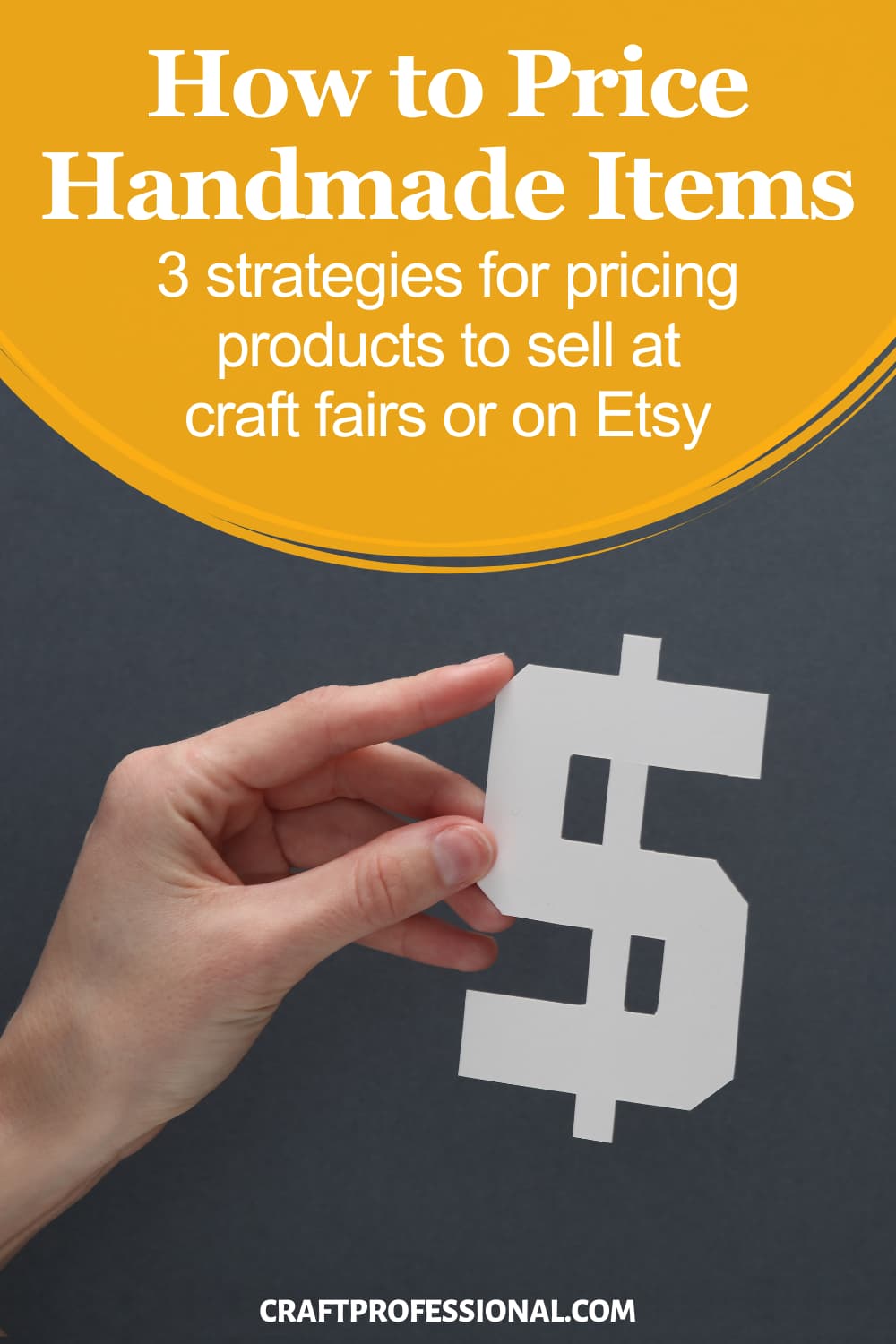- Home
- Craft Pricing
- How to Price Handmade Items
How to Price Handmade Items
There are many ways to price crafts. To keep things simple, we're going to look at three common pricing methods to consider:
- Competitive Pricing
- Cost Plus Pricing
- Value-Based Pricing
I'll explain how you can use each method. We'll also look at the pros and cons of each approach to help you determine if it is right for your business.

Competitive Pricing Strategy
What is Competitive Pricing?
What is Competitive Pricing?
Competitive pricing is exactly what it sounds like. You research your competitors' prices, and set prices for your products so they are in line with your competitors' prices.
How to Use Competitive Pricing
To use the competitive pricing method, you need to research your competitors.
What businesses should you research?
Look for companies that sell products similar to your own. For example, if you make handmade soap, look at the pricing of other companies that also sell handmade soap.
Research companies that sell products in the same locations and types of venues where you would like to sell your own products. Prices may vary significantly by geographic location. They can also vary a lot depending on the nature of the sales venue.
Here's one simple way to you can research competitors' prices.
If you'd like to sell at craft shows, find the websites for a few shows you'd like to participate in. Check out their list of vendors for the upcoming show or past vendors. Within that list, find the vendors who sell the same type of product as you make.
Now visit websites for those vendors. Check their products and confirm they are similar to your own. They don't have to be exactly the same but close enough that a shopper would consider them similar and in the same product category.
Once you confirm their products are similar enough to yours, make note of the prices they charge and any other relevant information (materials or size may be relevant, for example).
Repeat this research with several more similar businesses until you have enough information to see patterns in the pricing and price your own products similarly.
Make note of these competitors' websites as well, and save all of this information. You may want to return to it for future research.
You can do the same type of research if you plan to sell at other venues (online, on Etsy, for example).
Competitive Pricing Advantages
Competitive pricing can be an easy place to start. It's fairly simple to find information about competitors' prices, so you can make pricing decisions quickly and efficiently.
In the early stages of building your business, you may not have all of the information you need to use other pricing methods. Competitive pricing can give you a reasonable starting point for pricing while you learn more about your business.
When you use competitive pricing, you ensure your prices won't be out of line compared with other sellers. Pricing your products significantly higher or lower than similar items can hurt your sales and profits. Competitive pricing ensures you fit in with similar sellers.
Competitive Pricing Disadvantages
If you use this pricing model, you're not making sure your price is covering all of your costs because it is based on competition not the realities of your own business. Granted, your costs should be similar to a craft artist in same category, but there might be significant differences you're not aware of.
You can miss opportunities to increas profits if you use competitive pricing. Other methods require you to closely examine and account for your expenses, or look for ways to increase the price shoppers will pay for your products. Because competitive pricing is based on your competitors' business, and not your own, the process doesn't help you learn about your own business and ways to boost profits.
Some categories of crafts are hard to compare directly with competitors. If your product is quite unique within your category, you may have a hard time finding sellers with products that are similar enough to use as a basis for your own pricing.
Cost Plus Pricing Strategy
What is Cost Plus Pricing?
Cost plus pricing uses a formula to calculate the price of a product. Start with the cost to create the product (materials, labor, and overhead) and add markup (profit) to those expenses.
Basic cost plus pricing formula:
cost + profit = selling price
Formula based on cost plus pricing some craft sellers use:
materials + labor + overhead + profit = wholesale selling price
wholesale selling price x 2 = retail selling price
How to Use Cost Plus Pricing
For details about how to use a cost-plus based formula, check out this craft pricing formula explanation.
If you'd like to try this formula with an online calculator, check out this online craft price calculator.
Cost Plus Pricing Advantages
Cost plus pricing ensures you are pricing for profit. The formula accounts for all of your costs and adds in profit.
Cost plus pricing requires you to carefully examine your expenses, and that process can encourage you to find efficiencies in your business to increase profits.
Cost Plus Pricing Disadvantages
Cost plus pricing doesn't factor in market price. That is, it doesn't account for what people are willing to pay for your product.
The price you calculate may be higher or lower than competition. Both scenarios can hurt your sales.
If your products are priced higher than the market price, many shoppers won't buy unless you give them a very good reason to place a higher value on your products. If your products are priced below the market price, some shoppers will wonder what's wrong with your products and, as a result, won't buy.
Pricing formulas shouldn't be used without knowing the market price for similar products and considering how the price calculated with the formula compares with the market price.
Value-Based Pricing Strategy
What is Value-Based Pricing?
Value pricing means you set your prices based on the perceived value of your product.
What is perceived value?
Perceived value is what shoppers believe your product is worth. Perceived value can be influenced by factors inherent in your product such as quality materials and craftsmanship. It can also be influenced by factors that aren't directly tied to your product such as the venue where you're selling your product.
How to Use Value Based Pricing
A lot of factors go into forming the perceived value of your product. I've written in detail about how to increase perceived value to create more profitable crafts.
I've also written about how factors that aren't directly tied to your product can impact craft prices.
Key to successful value-based pricing is understanding exactly what your target customers value and then doing an excellent job of communicating to shoppers all of the ways they will benefit from buying your product.
Value Based Pricing Advantages
Value based pricing works particularly well for many types of handmade items. It encourages you to maximize the perceived value (and your profit) by highlighting all of the ways your product is special and worth paying more to own.
The nature of craft businesses typically makes competing with low prices a losing strategy. Shoppers buy handmade items because they are special. They value the skill and personal touch that goes into making each item. You reinforce that value when you set prices higher. Conversely, you undermine that value when you set prices low in an attempt to be competitive.
Value Based Pricing Disadvantages
Value based pricing can be tricky. It is subjective. You don't have clear formula or comparison of competitors as basis for your pricing decisions. It can be harder to determine the right price, especially if your business is new.
You need a deep understanding of what your target customer values and how that translates into the price they expect to pay for your product. This information can be tough to know, particularly when your business is new.
You'll need to do an excellent job of communicating value to shoppers in order to maximize perceived value. Your pricing strategy will reach into all elements of your business to use this method effectively.
How to Price Handmade Items
There is no single pricing method that is right for all craft businesses. You might even find one method works well when you're starting your business but another method is better once your business is more established.
For example, you might start off using the simple competitive pricing method. Once you understand your expenses and your customers better, you may switch over to use a pricing formula like cost plus pricing or value based pricing.
Focus on the single method that makes the most sense for your business, but consider informing your pricing decisions with the other methods as well.
If you use competitive pricing:
Run your expenses through a pricing formula to see how well the price you're using covers expenses and profit. Also work to increase the perceived value of the items you sell.
If you use cost plus pricing (or any other pricing formula):
Make sure you know the market price for your product, so you can ensure the price you calculate with a formula is in line with the price customers expect to pay. Work to increase the perceived value as well.
If you use value pricing:
Research the market price of similar products. It will tell you the base price shoppers will pay. You can then work to increase the perceived value above that base price. Plus run the numbers through a pricing formula to make sure you are covering your expenses plus profit.



New! Comments
Have your say about what you just read! Leave me a comment in the box below.